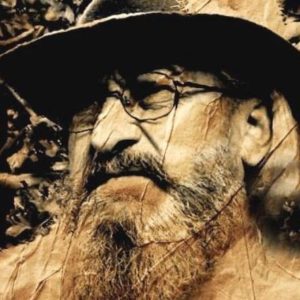GUGLIELMO BERTARELLI

Guglielmo Bertarelli was born the third of eight children, in Cavrasto (TN) on 29th December 1945.
His village, which lies beneath the Brenta Dolomites, shaped and aroused his love of nature and impressed a consciousness of human limitations compared with the power of nature. This awareness will always accompany him in his continual artistic advancement in the search for the impossible balance between humans and nature.
The original family, plagued by poverty, the father a simple stonemason, stirred in Bertarelli a special love for the forms of material. His father taught him how to work granite and hoped that his son would make use of his skills in order to earn his living and avoid hunger. He certainly would never have thought that his actions were largely responsible for exciting his son’s artistic spirit.
His first works, in the form of wood carving, were geometrical shapes and allowed Bertarelli to perfect his technique of carving using a material which is easier to form. Wood carving work provided the first materialistic satisfaction, allowed further training and opened the possibility to obtain naturalistic forms. The first finished sculpture was in the form of a sheep’s head. Bertarelli still remembers that this sculpture took a long time to produce and was finished in 1952.
His passion for sculpture was not well accepted by his family, particularly his mother, who could see no financial future in it. This mentality and way of thinking, resulted from hunger and survival difficulties, and was typical of farmers. This region is well known for the number of emigrants; people who were looking to improve their standard of living, and who saw that a better education could improve their economic situation. Bertarelli had the shapes and forms in his head, before they could be fully drawn out of the material.
Instead of remaining at school with its limited possibilities, he began an apprenticeship in an engineering workshop in 1959. This work gave him no satisfaction. In any spare moments, he joined in the activities of „Grazioso Orsinger“, a well-known artist painter in the area. So, through his observations, he was able to further develop his artistic talent and deepen his association with art.
In 1960, after the death of his father, he was forced to radically change his plans and to confront the harsh reality of everyday life. In a technical school in Trient he learned drawing and metalwork techniques and then he went to Germany, where he was initially employed in a sheet metal works and then later in a paint factory. Both experiences served him well and were important in the years to come for working with metal, paints and various materials. In Munich he frequented the meeting places of other artists and attended, on a part-time basis, various painting and sculpture courses at the local academy. The first works of the artist showed a lack of expression technique, but he was heading in the right direction and had luck when he moved to Milan. Here he worked with an author on the text about Italian transport and history. He carried out secretarial work and this allowed him to extend his scientific knowledge; he came into contact with artists and learned new techniques such as glass engraving, reality drawing, clay forming, etc., but he did not lose the essential contact with the academy.
In order to make a living, he took on temporary work. Through private exhibitions he sold several pictures, but he achieved no major results. He returned to his home and rented premises where he carried on his further training through experiments and trials with various materials.
Now it is other people who ask him to organise private exhibitions. His works, promoted by critics, have effective value. In his works, a new artist is appearing. An artist with fresh ideas, but who is still bound to the old magical mountain world, which taught him to love the eternal balance between nature and humans, the circle in which the powers of nature on humans succeed over the omnipotent mania to be God.
His researches and successes are numerous and great. By the end of 1980 he had created approximately 3’000 works of art. Then he decided to travel the world; many works were entrusted to him, as he is a great technician in many fields. In 2005 he again appeared as an artist. He started again as a sculptor. Now he marks his works “el Duca”, in honour of his grandfather, who was his great life-teacher and whose nickname he has now taken on. Today, we can celebrate the return of a great man!